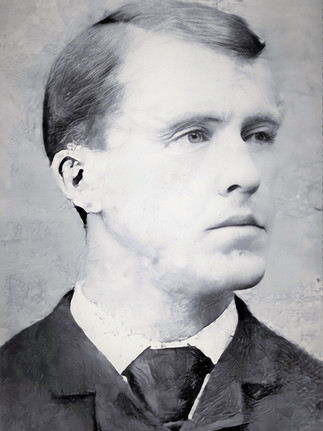The Village is Platted and F.A.K. Harris Comes to Town
- Bob Gernert
- Oct 28, 2024
- 4 min read
The railroad brought development to central Florida and Polk County. Travel guides and brochures from the 1870s and 1880s describe the area as a “cattle region” and “in many respects one of the most desirable portions of Florida.” The printed materials describe clear lakes, beautiful streams, first-rate pine and very productive clay subsoil.
In May of 1883, J. Blount and W. T. Whitledge (Bartow realtors and merchants) developed a town plan based on a grid system of blocks and tiers... a pattern that still exists today. The plan was divided into commercial, residential, and farmland areas. At the center a central park, oriented north-south, it ran two blocks bracketing the South Florida Railroad property.
Blount and Whitlege sold the first portion of their holdings to early settler Fredrick Amasa Knowles (F.A.K.) Harris who arrived in the area during 1884. Families such as the Eycleshimers, Jacksons and Sykes were in the area but not residing within the newly platted village. Peter D. Eycleshimer was among the first to purchase land within the village as yet unnamed.
Harris came to the area from Vermont after a tragic stay in Nebraska where his wife, Adele, was injured in a tornado. The Harrises (including one year-old son Bert) built both the first commercial and residential structure within the limits of the newly platted village. The family opened a mercantile business on the first floor and lived upstairs. The railroad was under construction at the time and Mrs. Harris sometimes cooked for the workers. For a short time, the railroad workers referred to the new settlement as “Harris Corner.” The Harris store was located at the corner of Fifth Street and Central Avenue N.W., facing east toward Central Park.

Mrs. Harris is remembered as a formidable presence, managing at times both family and business while F.A.K. was out of town. The story is told that on one occasion she sent son Bert to the kitchen to get bread. When he opened the breadbox there was a rattlesnake inside. Mrs. Harris, known to wear a firearm, proceeded to send the snake to its reward. Bert survived unscathed.
Mr. Harris is known as the “Father of Winter Haven” for having built the first building in the “town proper” or within the village limits. He also served as one of the village’s first postmasters. When Winter Haven formally incorporated in 1911, he served as a town councilman. Winter Haven adopted the city manager form of government in 1923. Harris descendants still live in the Winter Haven area.
WHITLEDGE OR WINTER HAVEN? THE VILLAGE IS NAMED
The land where Winter Haven exists today was owned earlier by an English company known as the Florida Land and Colonization Company. The home office was in London. Writing in her book “The History of Winter Haven,” Josephine Burr noted that “the company owned large portions of area land as late at 1882 but that Sydney O. Chase of the Chase and Sanborn Coffee Company owned a big portion up to 1884 and possibly later.”
Both F. A. K. Harris and Peter D. Eycleshimer arrived in the as-yet-unnamed village of Winter Haven in 1884. In fact, Eycleshimer arrived alone before Harris. Second in line to purchase land within the plat, he then returned home to Tomhannock, Rensalear County, New York for his family. While Harris has the distinction of purchasing the first land in the newly platted village, Eycleshimer and his wife are credited with naming the community.
While Eycleshimer was home getting his family, the Realtors Blount and Whitledge contacted him asking his thoughts on naming the village “Whitledge.” In the meantime Mr. Whitledge expressed his reluctance to put his own name on the town and asked Mrs. Eycleshimer if she could suggest a better one. In discussions with her husband they considered the possible future of this area of many lakes. They thought the town should suggest the reason for its existence – not only as a railroad stop and post office – but its potential as a winter resort. The Eycleshimers tested a number of descriptors with the word “Winter” finally settling on Winter Haven. Mr. Eycleshimer wrote Whitledge that he saw two options:
- If the town was to be a business center with post office and shipping facilities, then Whitledge seemed a good choice.
- But if the long-term goal was a beautiful winter resort, then Winter Haven would be a better name. According to the late Richard H. DeMott, Sr., on May 6, 1885 all streets, avenues and alleys were dedicated as though Winter Haven was a small city – in spite of the fact that very few existed except on paper.

NO, THE NAMES DID NOT GET MIXED UP!
A rumor persists that Winter Haven’s name was supposed to be Lakeland and vice-versa. The simplest explanation is the fact the Eycleshimers did not suggest “Lakeland.” But further documentation indicates Lakeland incorporated on January 1, 1885. Winter Haven was incorporated on June 22, 1911. The name “Lakeland” might have been more descriptive considering our numerous freshwater lakes… but it had already been taken by our sister city.
Next month: The Inmans and Florence Villa
Bob Gernert is a student of Winter Haven history and founded the Museum of Winter Haven History at the historic Women’s Civic League building on Lake Howard. If you have questions or information to share, please email bobgernert@gmail.com or telephone 863-206-6855.






